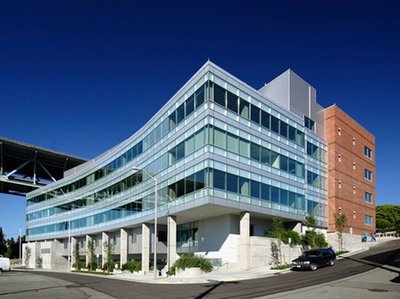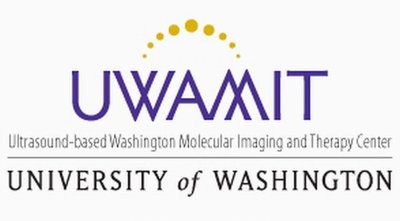October 28, 2010
Molecular imaging and therapy center to develop, commercialize technologies
Ultrasound, best known by many for snapping pictures of babies before they are born, could soon be a way to spot cancerous cells before a tumor develops, precisely monitor how a person responds to treatment, or deliver genetic therapies to their targets.
The Ultrasound-based Washington Molecular Imaging and Therapy Center was established this spring with a $5 million grant from the Life Science Discovery Fund. The UW center will discover, develop and commercialize new medical technologies.
Already the center is gaining attention. Director Tom Matula, a principal physicist in the UW’s Applied Physics Laboratory, was recently approached by a doctor at Seattle Children’s who faced a problem in an infant’s developing heart. Matula thinks his center can develop ultrasound imaging that will be able to track blood flow and diagnose the problem to weigh options before starting surgery.
Imaging techniques can help doctors determine when treatment is needed, which treatment is likely to be most effective, and when the risks of treatment outweigh the benefits.
“The whole concept of molecular imaging and therapies is so that a physician can understand a single person’s need. So they don’t waste resources on drugs or therapies that won’t work,” Matula said.
UWAMIT, as the center is known, is hosting a number of other events this fall, including an information session for potential faculty partners; a brainstorming session with pediatric cardiologists; an event for large business partners including Siemens USA, GE Healthcare and Phillips Healthcare; and another event for smaller companies and startups.
“This is a university-based tech incubator,” said UWAMIT program manager Justin Reed. “We’re all about connecting university innovation to clinical opportunity. That’s where we see the opportunity for job creation.”
The center has set itself the goal of creating 200 jobs within five years, through hiring of research and support staff as well as through partner companies and startups. It will work with the UW’s Coulter Program, part of a national group that helps commercialize academic research in biomedical engineering, to judge which ideas hold the most promise. It will then work with the UW’s Center for Commercialization to bring successful techniques to patients, either by partnering with existing companies or launching startups.
To date, most medical imaging has pictured physical structures such as bones, organs or tumors. Soon doctors may be able to see molecules, such as sugars, proteins or genes, and watch how they move through the body. Because such molecules are too small to image alone, researchers create specialized probes that attach to the target of interest and can sometimes also release drugs or heat pulses as treatment. Molecular imaging promises earlier and better diagnoses, and more customized treatment of conditions like cancer and heart disease.
Molecular imaging is now possible using costly techniques such as positron emission tomography, or PET, which involve radioactive molecules. The new center will develop molecular imaging and therapy using ultrasound, which is cheap, safe, and can penetrate deep inside the body.
Three initiatives are already under way. Matt O’Donnell, dean of the UW’s College of Engineering and the center’s director of research and development, is leading a project using a new low-cost technique, photoacoustic imaging, for early detection and treatment of prostate cancer. Andrew Brayman, a researcher at the Applied Physics Laboratory, is developing biomarkers that work with ultrasound to detect early stage cancer.
On the molecular therapy side, the new center will collaborate with the UW’s Center for Intracellular Delivery of Biologics, also funded by the Life Sciences Discovery Fund, to use ultrasound for delivering large-molecule drugs — such as viruses, proteins or genes — to the right place in the body. In the first such collaboration, Joo Ha Hwang, an assistant professor of gastroenterology, is targeting pancreatic cancer using pulses of high-intensity focused ultrasound to help larger drugs penetrate deeper into a tumor.
“It’s molecular medicine performed noninvasively,” O’Donnell said, “which means it can be done in your doctor’s office, it can be done cheaply, it can even be done remotely from another location.”
In addition to three principal researchers, the center plans to hire three new faculty members in the next year, one each in bioengineering, radiology and applied physics.
“As a team, we will develop tools that will enable earlier detection of disease, more cost-effective and less invasive intervention, and increase the accessibility of imaging sciences resources,” said Dr. Norman Beauchamp, UW professor and head of radiology and UWAMIT’s director of clinical translation.
A partnership announced earlier this year between Beauchamp and Ohio-based medical services company Cardinal Health, to develop radioactive imaging agents that detect and image cell activities associated with cancer, will collaborate with the new center.
The initial grant is intended as seed money. In the long term, the center plans to fund itself through federal research grants, industry partners, licensing revenue and startup companies. It aims to be a resource to help UW faculty turn research into products, and for companies who want to tap university expertise.
“Even more so, we want to reach clinicians who are out there on the front lines treating patients and are wondering, ‘Is there a better way?'” Matula said. “We encourage them to come to us and see if we can help them solve their problems.”


